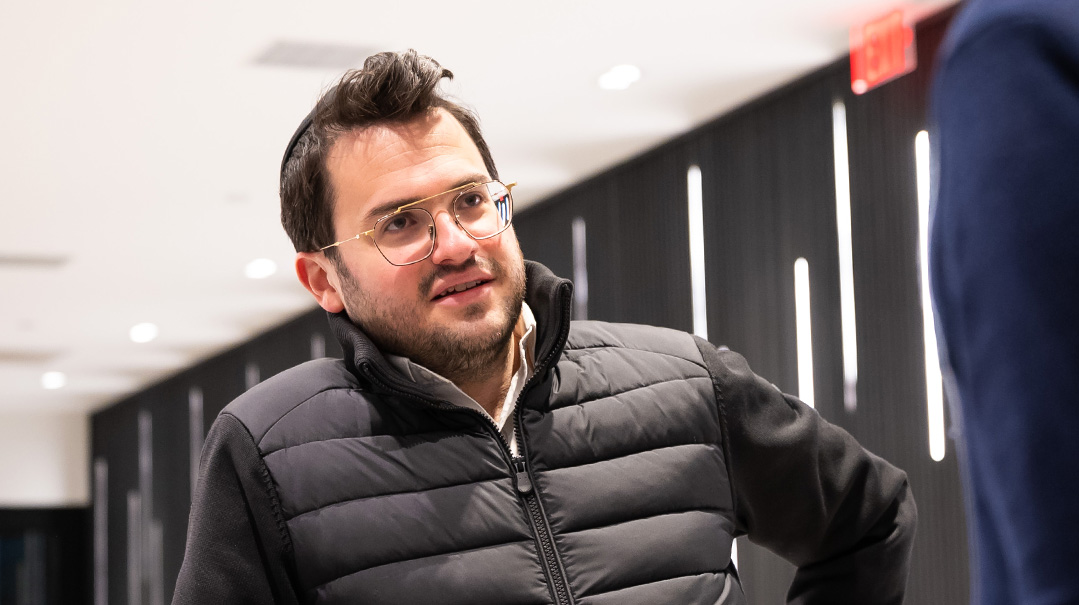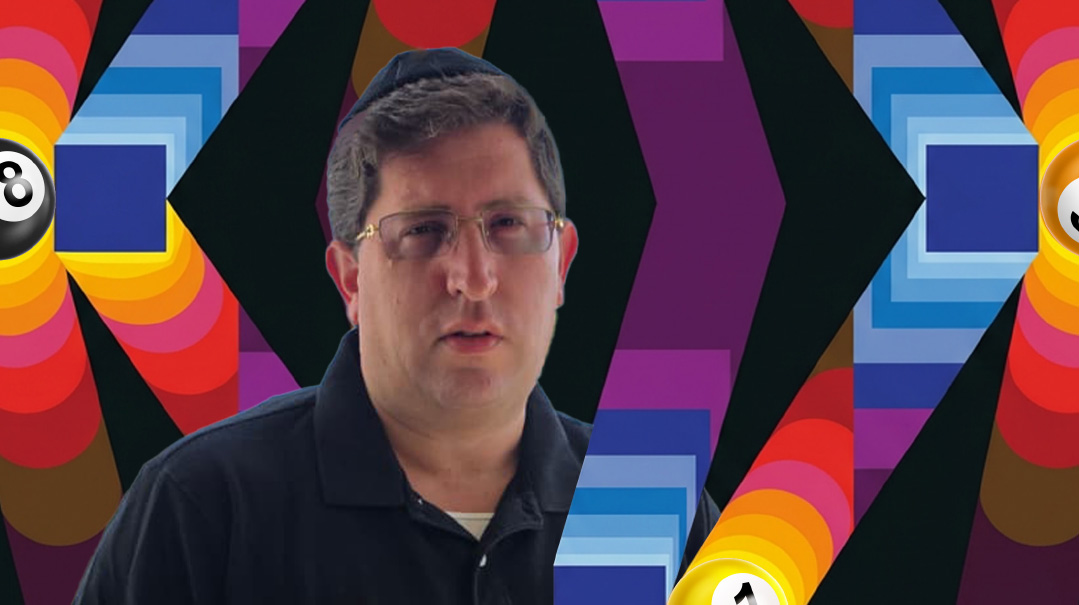Those Left Behind

Relatives share what it’s like to have a husband and child in captivity — with no end in sight

Photos: Flash90
“I think this deal should have happened long ago. At the end of the day, we have to bring them all back. There will be no security until everyone returns.”
—Lishay Miran-Lavy
“The fact that we have proof of life for my son doesn’t change my view on how this issue should be handled. I am convinced that Hamas will never return all the hostages through a deal.”
—Tzvika Mor
Lishay Miran-Lavy and Tzvika Mor agree on little politically, but they share an intense anguish as they relate what it’s like to have a husband and child on the other side — with no end in sight
More than 500 days have passed since Hamas dragged 251 Israelis into captivity in Gaza. The nightmarish news sent Jews around the world reeling. But with the passage of time, familiar routine dulls the shock, outrage, or grief. The trickle of releases over the last few weeks, accompanied by scenes of joyous family reunions, has taken the edge off the pain.
But some 73 people are still being held hostage in Gaza by the terrorists. Since the war began, people have spoken of “the hostages” as if they were a single entity. And while it’s true that they share the same cruel fate, behind each one are parents, siblings, a partner. Individual identities are blurred behind the collective term. And for the families of the captives whose names don’t appear on the lists for release, there is no routine, no normality. Each day is not just “24 more hours.” It’s an eternity.
The world looks pretty different for those hostages being released in “Phase One” and those slated for “Phase Two.” The first phase of Israel’s ceasefire deal with Hamas took effect on January 19, and over the 42 days of this phase, 33 hostages are supposed to be freed. The deal stipulates that another 64 hostages — not all of whom are believed to be alive — will be let go in the second phase, although that is still subject to negotiation.
As the Trump administration threatens severe punishment for Hamas if it abrogates any part of the deal, the Phase One hostages continue to be released — 19 Israelis and five Thai nationals, so far. But even that joy comes at a staggering cost. For each innocent civilian who regains freedom, Israel is forced to release dozens of convicted Hamas terrorists, with Jewish blood on their hands.
The hostages on the first list are discussed constantly — who, when, and in what condition they will be released. Those on the second list? Not so much. There is fear, uncertainty, and, above all, a chilling lack of clarity on their wellbeing.
In recent days, the families of ten hostages in the Phase Two group have received word that their loved ones might still be alive.
Omri Miran, a 47-year-old father of two, was kidnapped before his family’s eyes on October 7 from their home in Nachal Oz. For 16 long months, his wife, Lishay Miran-Lavy, and his two little girls, barely one and three years old, had no information of his well-being. Only with the release of Phase One hostages have they learned that he survived.
Eitan Mor, 23, was working as a security guard at the Nova Festival when he was taken. His father Tzvika, who lives in Kiryat Arba, likewise had no word as to whether his son was alive — but he also just received confirmation that he was.
Lishay Miran-Lavy and Tzvika Mor agree on very little, politically, and that includes the ceasefire deal in effect now that is enabling hostage releases. But they share an intense anguish — and above all, a slender hope that they cling to tightly.
They shared with Mishpacha what it’s like to have loved ones among those left behind.
Don’t Be a Hero
Scheduling the interview with Lishay Miran-Lavy was difficult, and she warned that the time we set would be tentative. When the time came, she was alone with her two little girls, Roni and Alma, and it was close to their bedtime. Sure enough, we spoke half an hour later than planned, with Lishay apologizing repeatedly for the delay — as if she didn’t already have enough on her plate.
For over 500 days, Lishay has fought as best she can for the release of her husband, Omri, a shiatsu therapist who spent his 47th birthday in captivity. At the same time, she has been raising two daughters who lived through the horrors of October 7 firsthand.
“Roni was two years old,” Lishay tells Mishpacha. “She remembers everything. She was there. They know that their father is in Gaza. She says it herself — ‘Bad people took Daddy to Gaza.’ I tell her that we are looking for him, that the soldiers are looking for him, that we hope he will be back soon.”
Her voice, although tinged with exhaustion, is still strong. She speaks as one drained from the fight but acutely aware that her determination is the only thing she has left.
Nachal Oz is about three kilometers north of the Gaza Strip. When the terrorists infiltrated the kibbutz, the Miran family managed to barricade themselves inside their safe room. But the terrorists captured a 16-year-old neighbor and told the family that if they didn’t open the door, he would be executed.
Omri opened the door. A few hours later, he was taken to Gaza. The last words Lishay said to him were: “I love you, I’ll protect our girls, we’re waiting for you, and don’t be a hero.”
That memory has haunted her for 16 months. But a few days ago, the news media reported that Lishay had finally received an encouraging sign: A hostage freed from Gaza confirmed he had seen Omri, and in relatively stable health, given the appalling conditions under which the hostages are kept.
Lishay acknowledges the reports but says she cannot share details. Omri’s brothers, Boaz and Nadav, have said the information is less hopeful than one might assume. The returning hostage reportedly confirmed that he saw Omri alive — in July. Seven months ago. Even so, the news offers a barely kindled hope.
“It gives us air to breathe, to know that he’s managing, that he’s staying strong, that he wants to come home,” Lishay says. “But I have to acknowledge that this proof is only valid for that point in time. Everything can change in an instant. They aren’t on vacation. They are in Gehinnom. We saw the condition of those who were recently released. And we live under constant pressure, constant fear. We know that about 30 people have been murdered in captivity, and there may be more.”
Though Omri was not included in Phase One, Lishay believes this ceasefire deal is the only way to bring them all home.
“I think this deal should have happened long ago,” she asserts. “At the end of the day, we have to bring them all back. There will be no security until everyone returns... The living, in life, so they can heal. The murdered, so they can be buried in the Land of Israel.”
Her voice breaks. “I have always said, from the very beginning, that I will never oppose anything that saves lives or that brings bodies back for burial in Israel. I don’t believe I have the right to, and I don’t think anyone does. I understand the difficulty. I understand the cost… I am a resident of Nachal Oz. I have spent my whole life in this region called Otef Aza. I look into the eyes of the families of the fallen, and my heart aches. I don’t want this to go on.”
That said, Lishay recognizes the burden borne by other Israeli families — those whose sons have fought to bring her husband home. “Our brave soldiers, who risk their lives every day — and some have given their lives in this war — they, too, must come home, to their families. And we must return to our homes.”
She does not dismiss the cost of the ceasefire — the terrorists going free to kill again — but insists that the country must bear it. “We have to believe that the State of Israel, as our security officials say, will know how to handle any security challenges that arise. If we cannot believe that, then there is no point to the State of Israel.
“And I say this as someone who lived through October 7, whose husband is a hostage. We have to believe in ourselves again.”
Pushing Forward
Tzvika Mor of Kiryat Arba, father of Eitan, 23, a security guard at the Nova Festival who was taken to Gaza that fateful Simchas Torah, also received word that his son was alive. He cannot confirm when Eitan was last seen alive or where the information comes from.
Since the war began, Mor has been one of the strongest advocates of a military solution, calling for a “total victory” over Hamas. He helped found the Tikvah Forum, which pushes for an intensive IDF operation in Gaza. He was among the loudest voices against the hostage-for-terrorist deal, arguing that his own son would have opposed it.
“We don’t want another Shalit deal,” he said, referring to the 2011 agreement that freed over 1,000 convicted terrorists in exchange for soldier Gilad Shalit.
Despite their shared circumstances — both being close relatives of hostages — Mor’s and Lishay’s perspectives on the deal could not be more different.
“The fact that we have proof of life for my son doesn’t change my view on how this issue should be handled,” he says. “I am convinced that Hamas will never return all the hostages through a deal.”
Even though he opposed the agreement, Mor acknowledges it must go forward. But he echoes the rhetoric of US president Donald Trump on how it should go: “Right now, we need to complete the remainder of Phase One and then issue an ultimatum — either they return all the hostages, or the war resumes.”
That means pushing forward — even with his son still in Hamas’s hands.
The drama surrounding the hostage crisis heightened with the release of Eli Sharabi, Or Levy, and Ohad Ben Ami on February 8. The images of their emaciated, hollowed-out faces went viral, a visual testament to their suffering. Fears for the well-being of the remaining hostages intensified.
Even President Trump weighed in: “They looked like Holocaust survivors. They were in horrible condition... and I don’t know how much longer we can take that.”
For families of the remaining hostages, an already unbearable situation worsened. But Lishay Miran-Lavy was harboring no illusions that they were receiving humane treatment.
“After the bodies of the six murdered hostages were found in late August, we don’t have to imagine — we know,” she says. “We know what state they were in, how much they weighed, how they lived. We’ve seen the conditions in the tunnels. None of this is a mystery to us. But those pictures [of the three released hostages] — the ones that went around the world — remind me of photos from many years ago. We’ve said ‘never again’ so many times. But ‘never again’ happened on October 7. And it’s still happening right now, at this very moment.”
Tzvika Mor is also obviously deeply concerned for the physical state of the remaining hostages, including that of his son. Though he was relieved and overjoyed for those who returned home, he cautions against letting the joyous scenes of reunions dictate policy.
“We cannot evaluate this situation based on emotions alone,” he insists. “We must act based on what is best and what is right for Israel.”
No One Is Doing Enough
Although they share the same fate, it is as if Lishay and Tzvika live in two entirely different worlds.
Mor views the conclusion of Phase One of the deal as a critical juncture. “We must use the ultimatum set by Trump to apply pressure and secure the release of all the hostages without having to free more terrorists,” he argues.
Lishay Miran-Lavy, on the other hand, focuses on Trump’s efforts to facilitate negotiations. “I believe the US government is doing a great deal to push forward the return of the hostages and to restore security to Israel… President Trump — I want to take this opportunity to thank him for everything he is doing, for the pressure he is applying.”
But Lishay also has a message for everyone in the self-proclaimed “free world.”
“Thank you all for your support, for standing with us,” she says. “But we need more. We need the entire world to take action. The people who were taken from their homes, in front of their children — some of whom watched their families be slaughtered — are suffering unimaginable horrors every single day. And the truth is, we are not doing enough.”
Her voice breaks again. “No one is doing enough. The whole world should be standing up and shouting, ‘Enough! Enough is enough!’ They must come home, and we must be able to live safely in our own country. And we haven’t done enough. I haven’t done enough. Because we have not yet brought them all back.
“I am not a politician or a diplomat. I don’t understand strategy. I am an academic. But as long as they are not here, every single one of them, it means no one has done enough.”
Before we end our conversation, I ask Lishay how she has handled all of this with her daughters.
“Both of them know that when Ima isn’t with them — and there are many days when I’m not — it’s because Ima is out there, asking for help to bring Abba home,” she says. “That is our reality. My daughter lived through it herself. She saw it with her own eyes. She saw them take her father away. There is no way to explain this to her in any other way.
“Of course, I tell her that Abba wants to come home. That he wants to, but they won’t let him. I tell her that Abba loves her, that Abba misses her. And I remind her that she loves him, that she wants to see him again.”
(Originally featured in Mishpacha, Issue 1050)
Oops! We could not locate your form.







